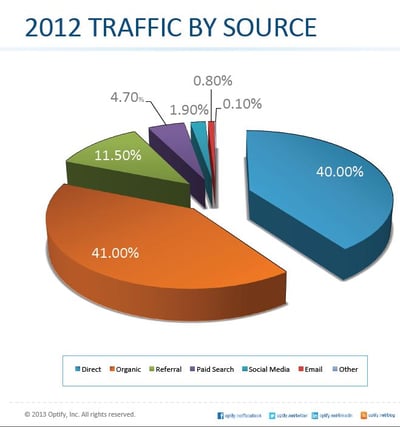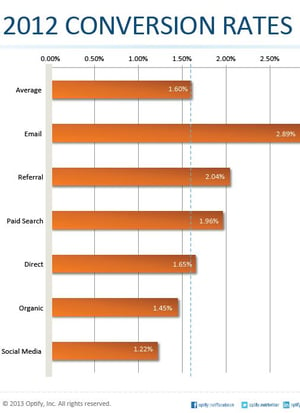Google Dominates 90 Percent of B2B Space

From search engine marketing (SEM) and search engine optimization (SEO) to social media and email, Web workers use a variety of tools to build and sustain website traffic. But knowing what is actually working to achieve these goals (Web-wide) is important not only for accurate budgeting of time and money, but also managing stakeholder expectations.
Optify's recently released 2012 B2B Marketing Benchmark Report can help. The company analyzed more than 27 million visits to nearly 600 B2B sites from various traffic sources throughout 2012.
 "We weren't shocked at the data, but we were surprised," said Optify Chief Marketing Officer Doug Wheeler.
"We weren't shocked at the data, but we were surprised," said Optify Chief Marketing Officer Doug Wheeler.
The first takeaway is that organic search serves as the number one driver of traffic to B2B websites, followed by direct traffic (40 percent) and referrals (11.50 percent). The report also finds that despite the increased adoption of social media by B2B in 2012, it ºs still only a fraction (1.90 percent) of total traffic to B2B websites. It is important to note, however, that the report also found that Google is responsible for nearly all of organic search, making it the single most important referring source of traffic.
"In the B2B space, 90 plus percent is coming from Google," said Wheeler. "When you are looking at where you are going to spend your money, that's imperative to know. Second, we are now seeing more than 40 percent of all organic visits from Google coming back as 'not provided.'
"Google is spending more of its resources, taking that data away and at some point, you have to understand how it is you are going to acquire traffic, customers living in a paid information world. The way to get that traffic is through paid media."
Very soon on the horizon, Wheeler expects seeing analytics, around what traffic is coming to your site, moving from free to paid. Understanding and optimizing everything Google is going to be imperative, but Web workers also need to find out if paid search makes financial sense to their companies.
The report states, "For the companies that run paid search campaigns successfully, paid search has the potential to be a sustainable, strong source of leads. But not all companies can, or should, run paid search campaigns. Analyze your paid search potential (price point, average cost per lead, realistic conversion rates, resources, etc.) to find out if this source is for you and how much you can get out of it."
Optify also looked at sources for converting traffic.
"Don't put away that checkbook for email," said Wheeler. "Email is number one in terms of conversion."
 According to Optify, the average conversion rate among all B2B websites in the report, across all sources, was 1.6 percent. Additionally, email shows the highest coversion rate compared to all other sources.
According to Optify, the average conversion rate among all B2B websites in the report, across all sources, was 1.6 percent. Additionally, email shows the highest coversion rate compared to all other sources.
"Surprisingly, organic search, the number one drive of traffic, is at the bottom of the conversion-rate list, second only to social media among the sources with lowest conversion traffic," read the report.
And while the report states that only 5 percent of B2B traffic comes from social media, Twitter outperforms Facebook in terms of lead conversion by more than a 9-1 ratio. Why does Twitter convert so well?
"I think it's because it's an accepted form of communication, almost like email," asid Wheeler. "It's just a different style, so people respond to it more instantly. They wouldn't bother communicating with you if they didn't want to respond, that's my pure, opinion."
The full report is available for free download.
"In reading this report, you might discover that you are doing better or worse than the published benchmarks and discover areas of potential for your marketing activities," said Wheeler.

Subscribe to Our Newsletter!
Latest in Marketing








